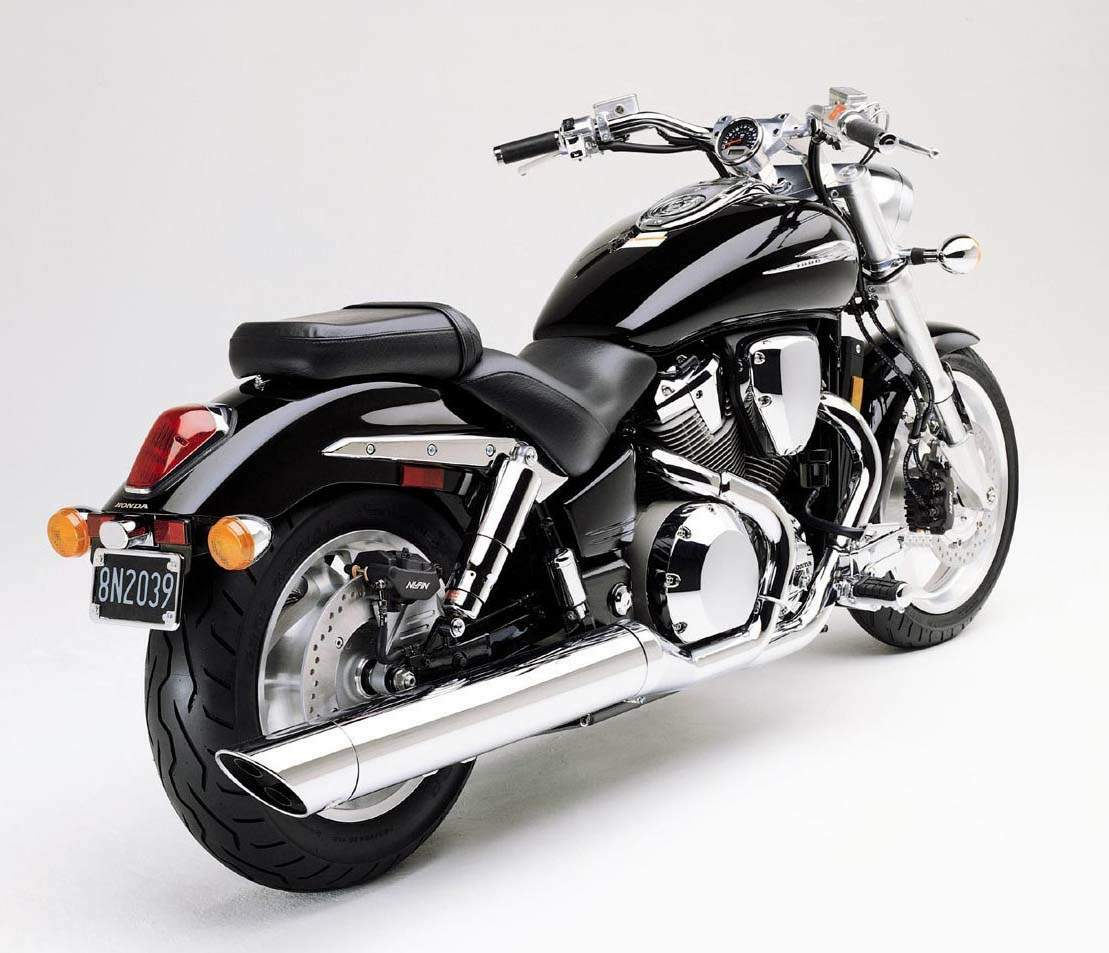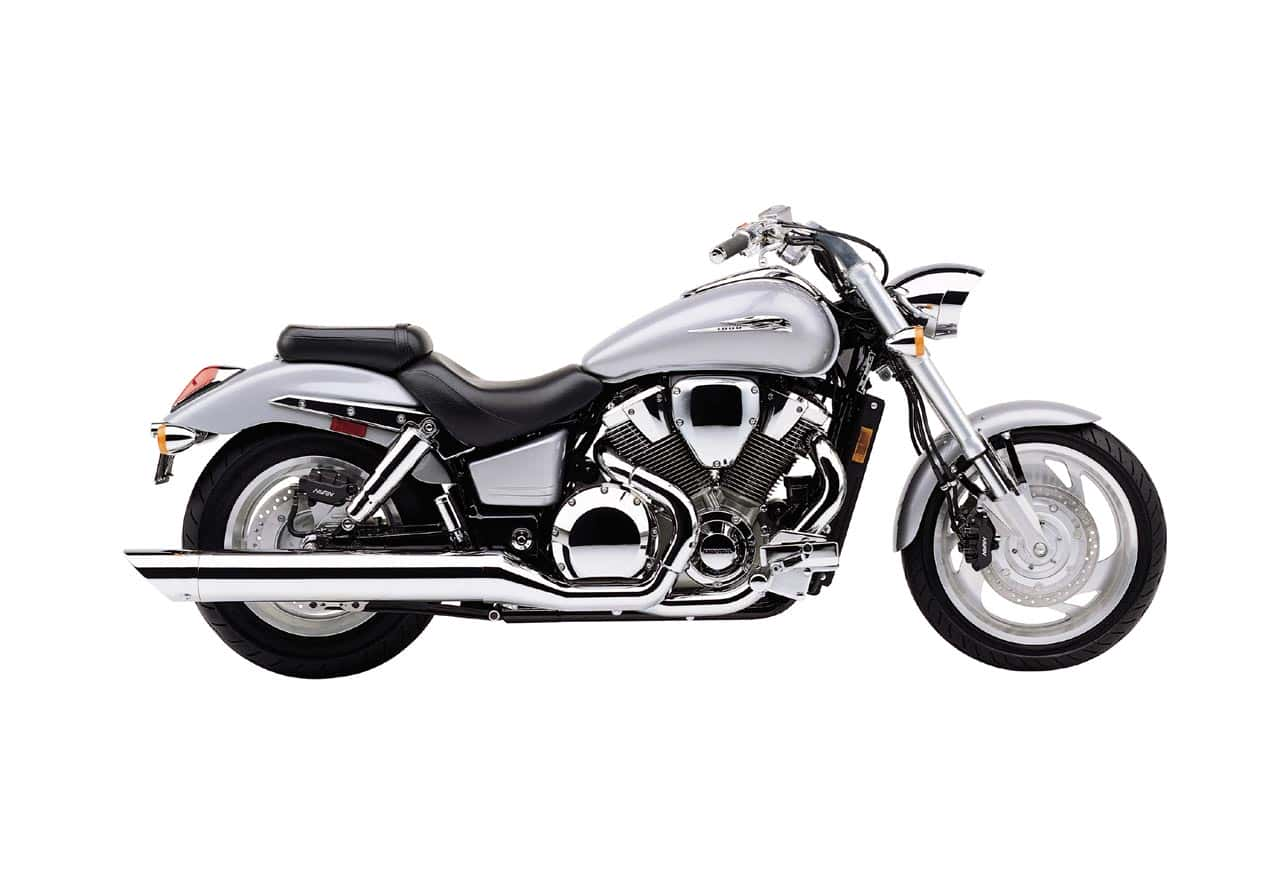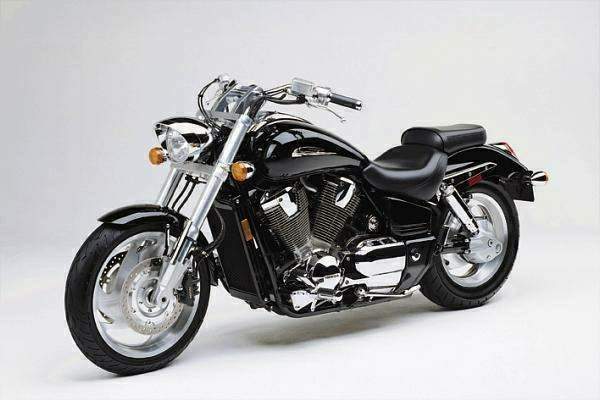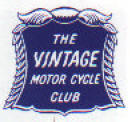



Honda finally announces the release of the VTX1800.
The following are excerpts from some of the excited parties...
Tokyo, October 22, 2001 - 'Honda Motor Co., Ltd. announces the release of the VTX, a powerfully styled large-displacement custom motorcycle equipped with a newly designed, water-cooled, 4-stroke 1800cc V2 engine that resonates power. The new model will go on sale October 23rd, 2001 through Honda's dealer network across Japan. The VTX, to be produced at Honda of America Manufacturing (HAM), Honda's U.S. production center, will be our American flagship model for our custom bikes. The engine will be the world's largest-displacement V2 available in a production motorcycle.' - Honda Worldwide
'Inspired by the Zodia concept shown at the 1995 Tokyo Motor Show, and after several years of marketplace chatter, and more than five years of closed-door development at Honda, the cruiser world has its enormous new entry. A street rod-styled bike, more bruiser than cruiser, driven by a massive 1795cc 52-degree, liquid-cooled and injection-fed V-twin - a motor that dwarfs Yamaha's 1600cc push-rod design, previously the hot-ticket for those inclined toward the big at heart. With impressive horsepower (we got 88.9 at 5250 rpm) and enough torque to pull trees -- 100.3 foot-pounds at 3000 rpm.
Oh, yeah, it's fast, too. On paper or pavement, Honda's VTX is much faster than any stock V-twin cruiser on your dealer's floor. With its 12.3 seconds at 105.5 mph quarter-mile time.' - Cycle Cruiser
'It's just a shame that I can't get Honda's superb F6C Valkyrie, out of my mind. A bike that proves to all - and Honda - that you don't need a vee-twin engine, let alone the biggest in production, to do the whole cruiser thing justice.' - First Ride (UK)
I'll leave this alone. No one needs my opinion on any of these bikes. Trust me.





Motorcycle collectors from around the globe converge on the Staffordshire County Showgrounds for Bonham's "Important Collectors' Motorcycles" auction featuring a 1930 981cc SS80 Brough Superior once belonging to Charles Edmund 'Titch' Allen.
Titch Allen was the godfather of the classic motorcycle movement. As a cub reporter he rode his 172cc Francis Barnett to the 1931 press conference that announced the opening of the Donington Park race circuit. Slipping away early, he rode around the unmade paths and woodlands tracks of the proposed circuit and staked his claim to being the first to lap these hallowed grounds.
Born in May 1915 in rural Nottinghamshire, Allen left school at 16 and, with a 'gift for the written word', his ambitious and forceful mother secured him a spot as a trainee reporter at the Nottingham Guardian. His experiences as a bike-riding, roving reporter during those years led indirectly to his becoming deeply involved with the resurrection of the Loughborough Motor Cycle Club.
With the onset of WWII, as did many other young British motorcyclists, Titch responded to the appeals for Dispatch Riders and signed up to the Motor Cyclist's Army Register. He served as a DR, concluding the war as a sergeant and with the BEM.
Allen's obsession with motorcycles never left him in these tempestuous times and he claimed that the acquisition of a 1930 Scott in 1942 was the catalyst for the formation of a Vintage Motor Cycle Club*. The great stimulus for this group was a series of articles on the adventures of tracking down and acquiring old bikes written by Captain Jim Hall in 'The Motor Cycle'. The idea was Jim's but it was the work of Titch that got the club off the ground with the historic inaugural meeting in the Hog's Back Pub in Surrey on April 28th 1946. Titch envisaged a club where historic motorcycles would be used in competition and also as everyday transport.
Allen's achievements were recognized in 2004 with an OBE. He spurned the presentation at Buckingham Palace, explaining: "I didn't want my mates to have to pay the congestion charge to go down there; in olden days they used to hang you for highway robbery." Instead, Lord Lieutenant of Leicestershire, Lady Gretton, made the presentation in Donington Park racetrack's Grand Prix Collection hall.
About the auction, the winning bidder would hear the gavel slam at $111,233 (68,700 GBP).
*The UK-based Vintage Motor Cycle Club now has nearly 20,000 members.





The Motor Maids are officially recognized as the world's first women's motorcycle club when they're granted Charter #509 by the AMA (American Motorcyclist Association).
Linda Dugeau's boyfriend hoarded pennies during the summer of 1930 so he could purchase a $15 motorcycle. "The minute I saw it I wanted to ride," said Dugeau.
"Girl riders", as the motorcycle magazines called them, were scarce in those days. As motorcycling became an obsession for Dugeau, she and her friend Dot Robinson sought to unite female motorcyclists in a club modeled after Amelia Earhart's sorority for women pilots called 'The 99ers'.
Dugeau, Robinson and 39 other women met for the first time in 1940. They settled on the name 'Motor Maids of America', and established two rules: A Motor Maid must own her own motorcycle, and she must at all times conduct herself like a lady. Indeed, its original colors were pink before, in 1944, changing to royal blue and silver gray at which the same time they adopted their shield logo. White gloves were also part of the uniform.
Dot Robinson would be named the first president (a position she would hold for the next 25 years) and would become one of the most influential women in American motorcycling.
A few things have changed. You can't get a bike for $15 anymore; the large touring models favored by Motor Maids cost anywhere from $10,000 to $20,000. The white gloves and ties that once distinguished club members are now donned only for parades. The organization's name has been updated to 'Motor Maids Inc.', but the Motor Maids are still out to prove that "women who ride motorcycles can be above reproach." Their four-page constitution and bylaws, revised in 1985, stipulate that members must be of good character and "at no time shall a member of the Motor Maids appear on her motorcycle in shorts or abbreviated costume."



Doug "Danger" Senecal breaks Robbie Knievel's 17 semi-truck record jump by one
truck in Las Vegas, Nevada.
Doug Danger first began making a name for himself in 1979
when he successfully jumped 10 cars in Palmer, Massachusetts. After 10 years of jumping assorted vehicles and obstacles in various venues up and down the East Coast, Danger finally makes the big league when he breaks Evel Knievel's record for the longest car jump , by clearing 20 cars in
Toronto, Canada in 1989.
Two years later, Doug would break the longest
ramp-to-ramp jump by an American, by clearing 38 cars at a total distance of 251
feet at the New Hampshire International Speedway in Loudon, New Hampshire. The jump lands him in the Guinness Book of World Records for the farthest jump ever completed. The fame is coming, now for a little rent money...
... just prior to a 1992 Robby Knieviel vs Doug Danger jump-off with a purse of over *$750K Doug misses an 11 car jump at Hudson Speedway in Hudson, New Hampshire, and suffers 17 broken bones including a fractured skull, ribs, femur, tibia and fibula. Doug remained in a coma for more than a month. The right side of his brain was found to be damaged and it would be over 3 years before he completely regains his memory. (*Eddie Kidd would step in and beat Robbie Knievel in the jump-off.)
On March 18, 2000, Doug Danger jumped an L-1011 Jumbo Jet wing tip-to- wing tip.
The jump was filmed for the "I Dare You" television show. The jump was 160'
across. The takeoff ramp was 4 feet wide and 20 feet high. The fuselage of the
plane was 27 feet off the ground. Doug had to reach a height of 30 feet in the
air.
Doug "Danger" Senecal, one of the greatest motorcycle daredevil you've probably never heard of.







C'mon, Ponch, let up...
Since the beginning of September the CHP (California Highway Patrol) has been erecting roadblocks every Sunday along a two-mile stretch of Mulholland about 200 yards west of the Rock Store. And although the authorities say the tactic has eliminated motorcycle racing, the Rock Store's proprietors say it is strangling their long-established business.
"I'm down about 85%," said Veronica, who with her husband has run the Rock Store for 28 years and is usually known simply as "Vern."
Hare Kokkinos, a Northridge resident taking a break from his latest weekend motorcycle ride, stood outside the Rock Store and described how Sunday afternoons used to be at one of the best-known biker pit stops not just in L.A., but in the world.
"This place was packed with metal; motorcycles were everywhere," said Kokkinos, nodding at a long parking lot off Mulholland Highway that fronts the store about two miles south of Agoura Hills.
"It was wall-to-wall bikers."
The Rock Store, a small cafe and grocery that draws a wildly eclectic mix of motorcycle enthusiasts , patch-holding club members and upscale "yuppie bikers," including Hollywood figures such as comic Jay Leno and actor Arnold Schwarzenegger. Far fewer motorcyclists come in now, say the store's owners, Ed and Veronica Savko, who blame a determined--and controversial--California Highway Patrol effort to stop motorcycle racing along the highway's scenic but deadly curves.
"They're trying to force us out of business," Ed insisted. "You wonder if this is a police state or something."
"The Highway Patrol is not out for a good purpose," snapped a middle-aged motorcyclist from Santa Monica who identified himself only as "Joe".
"They totaled three patrol cars out here chasing motorcyclists," he said with a laugh. "And I guess that made the CHP angry."





Evel Knievel pleads guilty to beating the crap out of Shelley Saltman.
While recuperating from his crash at the Chicago International Amphitheatre (jumping a 90' shark tank) the book Evel Knievel on Tour was released, written by Evel's promoter for the Snake River Canyon jump, Fox VP Shelly Saltman. The book paints an unflattering picture of Knievel's character, portraying him as abusive to his wife and kids and also as a heavy drug user. Evel freaks out. With both arms still in casts, he flies to California to confront Saltman. Outside of the 20th Century Fox studio commissary, one of Knievel's friends allegedly grabbed Saltman and held him, while Knievel attacked him with an aluminum baseball bat, screaming, "I'm going to kill you!" According to a witness to the attack, Evel starting swinging, connecting repeatedly with Shelley's head. While attempting to fend off his attacker Saltman's arm and wrist were shattered in several places before he finally fell to the ground like a wet sack of potato's (it would take numerous surgeries and permanent metal plates in his arm to eventually give Saltman back the use of his arm). The book was pulled from the shelves by the publisher after Evel threatened to sue. Saltman later produced documents in both criminal and civil court that proved that, although Knievel claimed to have been insulted by statements in his book, Shelley and his lawyers had actually been given editorial access to the book and Knievel had approved and signed off on every word prior to its publication.
On October 14, 1977, Evel Knievel pleaded guilty to battery and was sentenced to three years' probation and six months in county jail, during which he publicly flaunted his brief incarceration for the press.
Because of the assault and the jail-time that followed, Knievel lost most of his marketing endorsements, including Harley-Davidson and Ideal Toys.
In 1981, a civil lawsuit was filed; the civil court judge called Knievel’s acts “cowardly” and awarded Shelley Saltman $12.75 million in damages. Knievel declared himself to be bankrupt and none of the civil award was paid. In 2007, Saltman released a second book entitled Fear No Evel: An Insider's Look at Hollywood in which he told his side of the attack.
Then after Evel Knievel's death in late 2007, Saltman announced he would be suing the estate for the unpaid award from the civil suit, which he claims now amounts to over $100 million with interest.

































